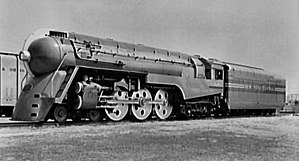This is a fascinating documentry on the workings of a steam train. It shows all the hard work it took to maintain a locomotive. And it was all done without computers!
Couldn't find any info on what happened to engine 5435, though.
~~~~~~~~~~~~~~~~~~~~~~~~~~~~~~~~~~~~~~~~~~~~~~~~
UPDATE~~~~~~~~~~~~~~~~~~~~~~~~~~~~~~~~~~~~~~~~~~~~~~~~
10/27/13 Terry has found info on the series! (Thanks, Detective Terry!) Here it is:
NYC Hudson
From Wikipedia, the free encyclopedia
|
|
This article needs additional citations for verification. (November 2007) |
| New York Central Hudson | |
|---|---|

J-3a Hudson on display at the 1939 World's Fair
|
|
| Specifications | |
| Power type | Steam |
| Builder | Alco-Schenectady (265); Lima Locomotive Works (10) |
| Build date | 1927–1931 (J-1); 1928–1931 (J-2); 1937–1938 (J-3) |
| Total produced | 275 |
| Configuration | 4-6-4 |
| Gauge | 4 ft 8 1⁄2 in (1,435 mm) |
| Career | |
| Railroad(s) | New York Central Railroad |
| Class | J-1, J-2 and J-3 |
| Number in class | 205 (J-1), 20 (J-2), 50 (J-3) |
| Disposition | All scrapped |
History
Although the Chicago, Milwaukee, St. Paul & Pacific Railroad (Milwaukee Road) was the first to design such locomotives (naming them Baltics), they were not built until after the NYC's Hudsons. NYC President Patrick E. Crowley named the units Hudsons after the Hudson River, which was in clear view from his office window.[1]The Hudson came into being because the existing 4-6-2 Pacific power was not able to keep up with the demands of longer, heavier trains and higher speeds. Given NYC's axle load limits, Pacific could not be made any larger; a new locomotive type would be required to carry the larger boilers. Lima Locomotive Works' conception of superpower steam as realised in the 2-8-4 Berkshire type was the predecessor to the Hudson. The 2-8-4's 4-wheel trailing truck permitted a huge firebox to be located after the boiler. The resulting greater steaming rate ensured that such a locomotive would never run out of power at speed — a common failing of older locomotives. Applying the ideas of the freight-minded Berkshire type to the Pacific resulted in a 4-6-4 locomotive.

Streamlined Hudson at the 1939 New York World's Fair
The Hudsons were of excellent quality. Locomotive #5344 had streamlining applied and named Commodore Vanderbilt.[3] The streamlining was later replaced to match the last ten J-3a locomotives that had been built with streamlining designed by Henry Dreyfuss. Two more J-3a locomotives had streamlining fitted in 1941 for Empire State Express service.[4] The streamlined locomotives featured prominently on NYC advertising.
The forte of all Hudsons was power at top speed. They were poor performers at low speed and the presence of a booster engine on the trailing truck was an absolute necessity for starting. For this reason, they were generally favored by railroads with flat terrain and straight routes. After the NYC, the Milwaukee Road was also fond of the Hudsons, acquiring 22 class F6 and six streamlined class F7s. The Atchison, Topeka & Santa Fe Railway also had 16, while the New York, New Haven & Hartford Railroad had 10 (#1400-1409) streamlined I-5 4-6-4s built by Baldwin in 1937 (nicknamed "Shoreliners"). Few railroads with hilly terrain acquired any.
A booster was prone to troubles, however, and gradually fell out of favor. Instead of a complicated booster, it was deemed preferential to have an extra pair of driving wheels, and thus better traction.
Trials of dual-purpose 4-8-2 Mohawks sealed the Hudson's fate. The Mohawk was nice, but it was still more suited to lower-speed hauling than high-speed power. In 1944, NYC received permission from the War Production Board to build a new, high-speed locomotive of the 4-8-4 type, combining all the advantages of the Hudson with those of the Mohawk. Many other railroads had taken to the 4-8-4 in the 1930s, generally calling them Northerns after the Northern Pacific Railway, which had first adopted them. By being a late adopter, the NYC had the chance to build on everyone else's experience. That locomotive proved to be exceptional, and the type on the NYC was named the Niagara. Since only 27 were built, however, they only took over the heaviest and most-prestigious trains; most Hudsons labored until the end of steam on NYC.
None of the NYC Hudson units survive; all were scrapped when the railroad dieselized.[4]
However, since the the Peppercorn A1 60163 Tornado was built in 2008, some volunteers known as The Hudson Steam Locomotive Revival Project (HPR) are seeking on building a live replica of the NYC J-3 Hudson numbered 5475 in Buffalo, New York.
Popular culture
- The character Connor from the Thomas & Friends television series that is stylized after a streamlined NYC Hudson.
- NYC Hudsons are featured on the cover of Van Halen's 2012 album A Different Kind of Truth and the Commodores 1975's album Movin' On.
Toy Trains
Lionel has issued the Hudson in the 1930s, 1950s, 1980s, and 2010s.MTH has also issued the Hudson since the late 1980s and Early 1990s.
See also
Notes
- Jump up ^ Staufer, Alvin F.; Edward L. May (1975). Thoroughbreds: The Most Famous Class of Locomotive in the World, New York Central's Hudson. A. F. Staufer. ISBN 978-0944513033.
- Jump up ^ Drury (1993). p. 279
- Jump up ^ Drury (1993). p. 271
- ^ Jump up to: a b Drury (1993). p. 273
References
- Drury, George H. (1993). Guide to North American Steam Locomotives. Waukesha, Wisconsin: Kalmbach Publishing Company. ISBN 0-89024-206-2.
No comments :
Post a Comment